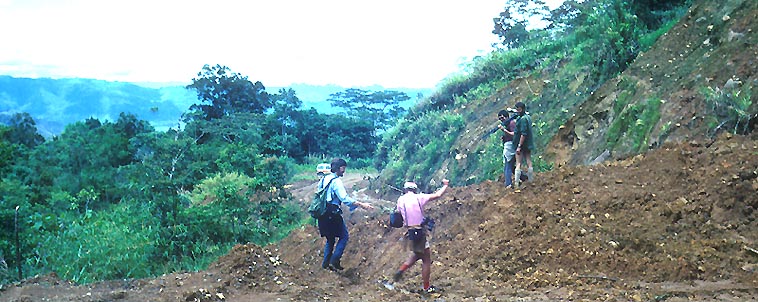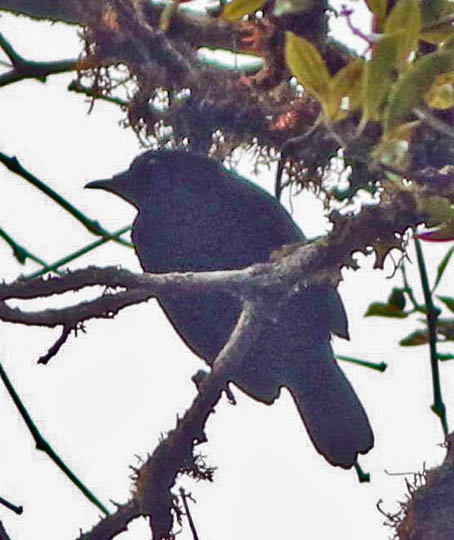
a web page by Don Roberson |
SATINBIRDS Cnemophilidae |
|
|
This group was initially thought to be related to bowerbirds [Ptilonorhynchidae]; indeed, ornithologists long sought for the bower of Crested "Cnemophilus" until Ernst Mayr (in Mayr & Gilliard 1954) found anatomical evidence linking it more closely with birds of paradise. Stonor (1937) had already moved Loria's "Cnemophilus" from the bowerbirds to the birds-of-paradise. Bock's (1963) osteology studies showed that this group was atypical of both bowerbirds and birds of paradise, although sharing more features of birds of paradise. They had a weak and broad-gaped bill, weak and non-manipulative feet, and an unossified nasal region. They shared some cranial characters, though, with bowerbirds. Bock (1963) and later Gilliard (1969) thought bowerbirds and birds of paradise to be closely related, and to have arisen from the same ancestor. Bock (1963) proposed that the cnemophilines (plus MacGregor's Bird-of-Paradise Macgregoria pulchra) were an ancient group in that lineage that later led to modern bowerbirds and birds-of-paradise. That was the status when I visited New Guinea in 1983 — they were considered an early lineage of birds-of-paradise. We searched for them on Trauna Ridge, Papua New Guinea, in October 1983. A huge mudslide had blocked our drive to Jimi Valley and in this shot my friends Steve Wilson (left), Brian Finch (pink shirt) and Chris Spooner (upper right; with scope) are crossing it with some difficulty. It was just beyond this spot that we located what was then called "Yellow-breasted Bird-of-Paradise." |
 |
| These are very poorly known birds; only recently has the name "satinbirds" been adopted for the Family. The DNA research of Sibley & Ahlquist (1990) showed that bowerbirds and birds-of-paradise were not closely related. Rather, both the bowerbirds and the cnemophilines are early lineages of the great corvid assemblage that arose in Australasia. Frith & Beehler (1998) acknowledged this, but considered cnemophilines more closely related to birds of paradise than anything else. For one thing, recent information about the nest, eggs, and young of Crested Satinbird shows that it is unlike bowerbirds. Yet, Frith & Beehler (1998) admit that "the cnemophilines may, in fact, not be birds-of-paradise" (at page 174) but "it is certainly convenient to treat these three species" as birds-of-paradise. This was the status quo until Cracraft & Feinstein (2000) published molecular evidence that cnemophilines are not closely related to birds of paradise. The biochemical evidence from mitochondrial DNA, as well as some fossil and phylogenetic evidence, show that the cnemophilines, like bowerbirds, are an ancient lineage near the base of the corvoid tree. They are not especially close to bowerbirds, though; the current evidence suggests that their closest relatives may be the cuckoo-shrikes [Campephagidae]. |
Searching out any of the satinbirds is not easily done. All are "highly frugivorous montane birds which are rather small, sexually dimorphic, compact with rounded wings, and generally unobtrusive habits" (Beehler et al. 1986). Crested Satinbird (once also called the "Sickle-crested Bird-of-Paradise") recalls a MacGregor's Bowerbird Amblyornis macgregoriae (the females are especially similar) and both live in similar habitats. Coates (1990) calls it "an inconspicuous, compact, sluggish frugivore inhabiting high mountain forest and shrubbery. It is, however, probably the best known of the group since the nest and young have been studied and photographed; e.g., Cliff & Dawn Frith's photos of the nest, with female and young, are published in Coates (1990). It was regular for a time on the grounds of Kumul Lodge near Mt. Hagen, where Simon & Julia took the featured photo (top of this page). When I was at Kumul, males were no longer visiting the lodge feeder. Yellow-breasted Satinbird is the least known. Almost nothing is known of its biology, and it seems scarce and local within the patches of habitat along the central ranges east to the base of the Huon Peninsula. While the colorful or exotic males are distinctive, females and young birds are quite drab, making them even more inconspicuous. Alas, although they sometimes move in small groups, most birds encountered seem to such dull-plumaged birds. Fully outfitted males are scarce (Coates 1990, pers. obs.). My experiences in 1983 with two species in cloud forest at about 9000' (2700m) at Murmur Pass, Mt. Hagen, were disappointing. The single Crested was a female-plumaged bird and the single Loria's, although a male, flew across road in front of us as we walked and much better views were desired. Had not Brian Finch been with us, I wonder whether we would have identified it. Finally, while we saw three Yellow-breasted Satinbird in roadside forest just past the landslide on Trauna Ridge (1800m = 6000' elev; top photo, above), they were all immature birds. Thus, while I've ticked all three species, I had not obtained a satisfying view of a male of any species until this male Loria's (left) at Tari Gap in 2016. |
Photos: Simon Woolley & Julia Casson photographed the male Crested Satinbird Cnemophilus macgregorii at Kumul Lodge, Papua New Guinea, on 8 July 2009. The photo of Trauna Ridge, Papua New Guinea, and the habitat of Yellow-breasted Satinbird was taken on 27 Oct 1983. The male Loria's Satinbird Cnemophilus loriae was at Tari Gap, Papua New Guinea, on 8 Sep 2016. All photos © D. Roberson, except that attributed to Simon Woolley & Julia Casson who hold that copyright, used with permission; all rights reserved. Family book: Rating
Family book: Rating
Literature cited:
|
 The
Cnemophilidae is a small group of little studied passerines, endemic to
the uplands of mainland New Guinea. There are just three species, one
of which is the colorful Crested Satinbird (left, in
an excellent portrait by Simon Woolley & Julia Casson). These birds
were once considered to be birds-of-paradise. Frith & Beehler
(1998) considered them a subfamily and termed them the "wide-gaped
birds of paradise." This same approach was used in the Handbook of the Birds of the World
(Frith & Frith 2009), although by then the DNA evidence proved that
they were not birds-of-paradise. Now all global lists consider them a
family.
The
Cnemophilidae is a small group of little studied passerines, endemic to
the uplands of mainland New Guinea. There are just three species, one
of which is the colorful Crested Satinbird (left, in
an excellent portrait by Simon Woolley & Julia Casson). These birds
were once considered to be birds-of-paradise. Frith & Beehler
(1998) considered them a subfamily and termed them the "wide-gaped
birds of paradise." This same approach was used in the Handbook of the Birds of the World
(Frith & Frith 2009), although by then the DNA evidence proved that
they were not birds-of-paradise. Now all global lists consider them a
family.  There are just three species. We've mentioned two of them above; the third is Loria's Satinbird (left).
Loria's Satinbird may have the broadest range in the central highlands,
mostly from 2000-4000m, but is inconspicuous except at fruiting trees.
This male (left) is in such a fruiting tree, and there was a female
foraging there as well.
There are just three species. We've mentioned two of them above; the third is Loria's Satinbird (left).
Loria's Satinbird may have the broadest range in the central highlands,
mostly from 2000-4000m, but is inconspicuous except at fruiting trees.
This male (left) is in such a fruiting tree, and there was a female
foraging there as well.  (4.5 out of 5 possible stars)
(4.5 out of 5 possible stars)